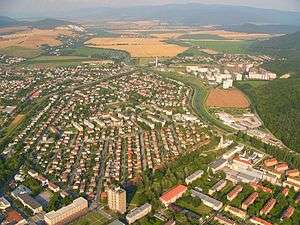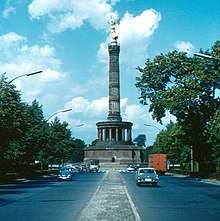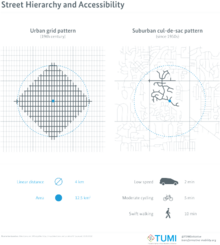Urban planning
Urban planning is a technical and political process concerned with the development and design of land use and the built environment, including air, water, and the infrastructure passing into and out of urban areas, such as transportation, communications, and distribution networks.[1] Urban planning deals with physical layout of human settlements.[2] The primary concern is the public welfare,[1][2] which includes considerations of efficiency, sanitation, protection and use of the environment,[1] as well as effects on social and economic activities.[3] Urban planning is considered an interdisciplinary field that includes social science, architecture, human geography, politics, engineering and design sciences. It is closely related to the field of urban design and some urban planners provide designs for streets, parks, buildings and other urban areas.[4] Urban planning is also referred to as urban and regional planning, regional planning, town planning, city planning, rural planning, urban development, physical planning, urban management or some combination in various areas worldwide.

Urban planning guides orderly development in urban, suburban and rural areas.[5] Although predominantly concerned with the planning of settlements and communities, urban planning is also responsible for the planning and development of water use and resources, rural and agricultural land, parks and conserving areas of natural environmental significance. Practitioners of urban planning are concerned with research and analysis, strategic thinking, architecture, urban design, public consultation, policy recommendations, implementation and management.[2] Enforcement methodologies include governmental zoning, planning permissions, and building codes,[1] as well as private easements and restrictive covenants.[6]
Urban planners work with the cognate fields of architecture, landscape architecture, civil engineering, and public administration to achieve strategic, policy and sustainability goals. Early urban planners were often members of these cognate fields. Today urban planning is a separate, independent professional discipline. The discipline is the broader category that includes different sub-fields such as land-use planning, zoning, economic development, environmental planning, and transportation planning.[7]
History

There is evidence of urban planning and designed communities dating back to the Mesopotamian, Indus Valley, Minoan, and Egyptian civilizations in the third millennium BCE. Archaeologists studying the ruins of cities in these areas find paved streets that were laid out at right angles in a grid pattern.[9] The idea of a planned out urban area evolved as different civilizations adopted it. Beginning in the 8th century BCE, Greek city states were primarily centered on orthogonal (or grid-like) plans.[10] The ancient Romans, inspired by the Greeks, also used orthogonal plans for their cities. City planning in the Roman world was developed for military defense and public convenience. The spread of the Roman Empire subsequently spread the ideas of urban planning. As the Roman Empire declined, these ideas slowly disappeared. However, many cities in Europe still held onto the planned Roman city center. Cities in Europe from the 9th to 14th centuries, often grew organically and sometimes chaotically. But in the following centuries some newly created towns were built according to preconceived plans, and many others were enlarged with newly planned extensions.[11] From the 15th century on, much more is recorded of urban design and the people that were involved. In this period, theoretical treatises on architecture and urban planning start to appear in which theoretical questions are addressed and designs of towns and cities are described and depicted. During the Enlightenment period, several European rulers ambitiously attempted to redesign capital cities. During the Second French Empire, Baron Georges-Eugène Haussmann, under the direction of Napoleon III, redesigned the city of Paris into a more modern capital, with long, straight, wide boulevards.[12]
Planning and architecture went through a paradigm shift at the turn of the 20th century. The industrialized cities of the 19th century grew at a tremendous rate. The evils of urban life for the working poor were becoming increasingly evident as a matter of public concern. The laissez-faire style of government management of the economy, in fashion for most of the Victorian era, was starting to give way to a New Liberalism that championed intervention on the part of the poor and disadvantaged. Around 1900, theorists began developing urban planning models to mitigate the consequences of the industrial age, by providing citizens, especially factory workers, with healthier environments. The following century would therefore be globally dominated by a central planning approach to urban planning, not necessarily representing an increment in the overall quality of the urban realm.
At the beginning of the 20th century, urban planning began to be recognized as a profession. The Town and Country Planning Association was founded in 1899 and the first academic course in Great Britain on urban planning was offered by the University of Liverpool in 1909.[13] In the 1920s, the ideas of modernism and uniformity began to surface in urban planning, and lasted until the 1970s. Many planners started to believe that the ideas of modernism in urban planning led to higher crime rates and social problems.[3][14] Urban planners now focus more on individualism and diversity in urban centers.
Theories

Planning theory is the body of scientific concepts, definitions, behavioral relationships, and assumptions that define the body of knowledge of urban planning. There are eight procedural theories of planning that remain the principal theories of planning procedure today: the rational-comprehensive approach, the incremental approach, the transactive approach, the communicative approach, the advocacy approach, the equity approach, the radical approach, and the humanist or phenomenological approach.[15]
Technical aspects
Technical aspects of urban planning involve the applying scientific, technical processes, considerations and features that are involved in planning for land use, urban design, natural resources, transportation, and infrastructure. Urban planning includes techniques such as: predicting population growth, zoning, geographic mapping and analysis, analyzing park space, surveying the water supply, identifying transportation patterns, recognizing food supply demands, allocating healthcare and social services, and analyzing the impact of land use.
In order to predict how cities will develop and estimate the effects of their interventions, planners use various models. These models can be used to indicate relationships and patterns in demographic, geographic, and economic data. They might deal with short-term issues such as how people move through cities, or long-term issues such as land use and growth.[16]
Building codes and other regulations dovetail with urban planning by governing how cities are constructed and used from the individual level.[17]
Urban planners
An urban planner is a professional who works in the field of urban planning for the purpose of optimizing the effectiveness of a community's land use and infrastructure. They formulate plans for the development and management of urban and suburban areas, typically analyzing land use compatibility as well as economic, environmental and social trends. In developing any plan for a community (whether commercial, residential, agricultural, natural or recreational), urban planners must consider a wide array of issues including sustainability, existing and potential pollution, transport including potential congestion, crime, land values, economic development, social equity, zoning codes, and other legislation.
The importance of the urban planner is increasing in the 21st century, as modern society begins to face issues of increased population growth, climate change and unsustainable development. An urban planner could be considered a green collar professional.[18]
Some researchers suggest that urban planners around the world work in different "planning cultures", adapted to their local cities and cultures.[19] However, professionals have identified skills, abilities and basic knowledge sets that are common to urban planners across national and regional boundaries.[20][21][22]
See also
- Bicycle-friendly
- Circulation planning
- Cycling infrastructure
- Development studies
- Domestic travel restrictions
- Epidemiology
- Index of urban planning articles
- List of planned cities
- List of planning journals
- List of urban planners
- List of urban theorists
- Low emission zone
- Planning cultures
- Regional planning
- Road traffic safety
- Rural development
- Smart city
- Urban density
- Urban economics
- Urban history
- Urban informatics
- Urban planning in communist countries
- Urban studies
- Urban theory
- Land recycling
References
- "What is Urban Planning". School of Urban Planning, McGill University. Archived from the original on 8 January 2008.
- Taylor, Nigel (1998). Urban Planning Theory Since 1945. Los Angeles: Sage. pp. 3–4. ISBN 978-0-7619-6093-5.
- Midgley, James (1999). Social Development: The Developmental Perspective in Social Welfare. Sage. p. 50. ISBN 978-0-8039-7773-0.
- Van Assche, K., Beunen, R., Duineveld, M., & de Jong, H. (2013). Co-evolutions of planning and design: Risks and benefits of design perspectives in planning systems. Planning Theory, 12(2), 177-198.
- Caves, R. W. (2004). Encyclopedia of the City. Routledge. p. 704. ISBN 978-0415862875.
- Smit, Anneke; Valiante, Marcia (2015). "Introduction". In Smit, Anneke; Valiante, Marcia (eds.). Public Interest, Private Property: Law and Planning Policy in Canada. Vancouver, British Columbia: University of British Columbia Press. pp. 1–36, page 10. ISBN 978-0-7748-2931-1.
- "What Is Planning?". American Planning Association. Archived from the original on 10 March 2015.
- Hass-Klau, Carmen. "Motorization and Footpath Planning During the Third Reich." The Pedestrian and the City. Routledge, 2014.
- Davreu, Robert (1978). "Cities of Mystery: The Lost Empire of the Indus Valley". The World’s Last Mysteries. (second edition). Sydney: Readers’ Digest. pp. 121-129. ISBN 0-909486-61-1.
- Kolb, Frank (1984). Die Stadt im Altertum. München: Verlag C.H. Beck. pp. 51-141: Morris, A.E.J. (1972). History of Urban Form. Prehistory to the Renaissance. London. pp. 22-23.
- Boerefijn, Wim (2010). The foundation, planning and building of new towns in the 13th and 14th centuries in Europe. An architectural-historical research into urban form and its creation. Phd. thesis Universiteit van Amsterdam. ISBN 978-90-9025157-8.
- Jordan, David (1992). "Baron Haussmann and Modern Paris". American Scholar. 61 (1): 99.
- Fainstein, Susan S. Urban planning at the Encyclopædia Britannica
- Morris, Eleanor Smith; et al. (1997). British Town Planning and Urban Design: Principles and policies. Harlow, Essex, Enngland: Longman. pp. 147–149. ISBN 978-0-582-23496-3.
- Whittmore, Andrew (2 February 2015). "How Planners Use Planning Theory". Planetizen. Retrieved 24 April 2015. citing Whittemore, Andrew H. (2014). "Practitioners Theorize, Too Reaffirming Planning Theory in a Survey of Practitioners' Theories". Journal of Planning Education and Research. 35 (1): 76–85. doi:10.1177/0739456X14563144.)
- Landis, John D. (2012). "Modeling Urban Systems". In Weber, Rachel; Crane, Randall (eds.). The Oxford Handbook of Urban Planning. Oxford, England: Oxford University Press. pp. 323–350. ISBN 978-0-19-537499-5.
- Codes, rules, and standards are part of a matrix of relations that influence the practice of urban planning and design. These forms of regulation provide an important and inescapable framework for development, from the laying out of subdivisions to the control of stormwater runoff. The subject of regulations leads to the source of how communities are designed and constructed—defining how they can and can't be built—and how codes, rules, and standards continue to shape the physical space where we live and work. Ben-Joseph, Eran (2012). "Codes and Standards in Urban Planning and Design". In Weber, Rachel; Crane, Randall (eds.). The Oxford Handbook of Urban Planning. Oxford, England: Oxford University Press. pp. 352–370. ISBN 978-0-19-537499-5.
- Kamenetz, Anya. "Ten Best Green Jobs for the Next Decade". fastcompany. Fast Company. Archived from the original on 26 August 2012. Retrieved 14 January 2009.
- Friedman, John (2012). "Varieties of Planning Experience: Toward a Globalized Planning Culture?". In Weber, Rachel; Crane, Randall (eds.). The Oxford Handbook of Urban Planning. Oxford, England: Oxford University Press. pp. 87–98. ISBN 978-0-19-537499-5.
- "American Institutes of Certified Planners Certification". American Planning Association. American Planning Association. Retrieved 20 July 2017.
- "Professional standards". Royal Institute of Town Planners. Royal Town Planning Institute. Retrieved 20 July 2017.
- "About ISOCARP". International Society of City and Regional Planners. Retrieved 20 July 2017.
Further reading
- Pennington, Mark (2008). "Urban planning". In Hamowy, Ronald (ed.). The Encyclopedia of Libertarianism. Thousand Oaks, CA: SAGE; Cato Institute. pp. 517–18. doi:10.4135/9781412965811.n316. ISBN 978-1-4129-6580-4. LCCN 2008009151. OCLC 750831024.CS1 maint: ref=harv (link)
External links
Library guides for urban planning
- Libraries. "Urban Planning Resources". Research Guides. USA: Arizona State University.
- Library. "Urban Planning". Research Guides. University of California, Los Angeles. Archived from the original on 30 March 2014. Retrieved 21 March 2015.
- Avery Architectural and Fine Arts Library. "Urban Planning". Research Guides. New York: Columbia University. Archived from the original on 2 April 2015. Retrieved 21 March 2015.
- Library. "Urban & Regional Policy". Research Guides. USA: Georgia Tech.
- Harvard University Graduate School of Design. "Urban Planning and Design". Research Guides. Massachusetts: Harvard Library.
- Hunter College Libraries. "Urban Affairs & Planning". Topic Guides. New York City: CUNY Hunter College. Archived from the original on 22 February 2014. Retrieved 21 March 2015.
- University Library. "City Planning". LibGuides. University of Illinois at Urbana–Champaign.
- MIT Libraries. "Urban Studies & Planning". Research Guides. Massachusetts Institute of Technology.
- "Urban & Regional Planning". Research Guides. USA: University of Michigan.
- Library. "Urban Studies & Planning". Research Guides. Oregon, USA: Portland State University. Archived from the original on 2 April 2015. Retrieved 21 March 2015.